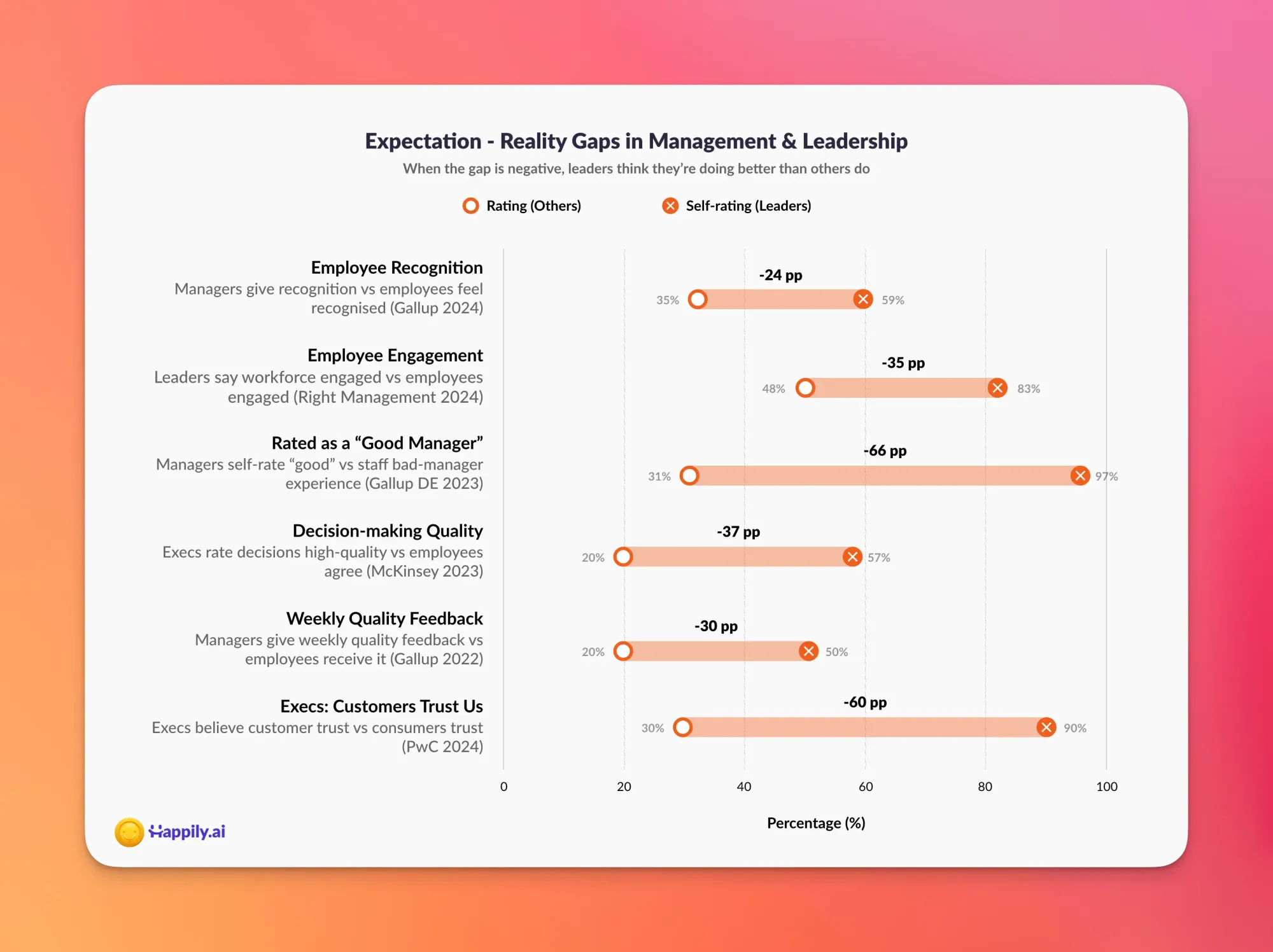Why Leaders Must Measure What Their Teams Actually Experience
There’s a growing disconnect in today’s workplaces: the gap between how leaders perceive themselves and how their teams experience them. It’s a silent threat to trust, engagement, and execution—and it’s more widespread than many realize.
The Leadership Perception Gap

Across industries and regions, leaders consistently rate themselves more favorably than their teams do. These overestimations aren’t limited to a single trait. They show up across feedback, recognition, communication, decision-making, and customer trust. In other words, the gap is multifaceted and deeply rooted.
This isn’t simply a problem of ego. It’s often a product of poor feedback loops, limited data, and environments where psychological safety is weak. When employees don’t feel safe speaking up or questioning decisions, leaders operate in a filtered reality. The result? A leadership team confident in its approach, while the rest of the organization experiences disengagement and misalignment.
A Problem That Compounds
What makes this issue even more challenging is that it compounds with hierarchy. Perception gaps exist at every layer of management. Each level adds another filter to the flow of information. A team lead might believe their feedback is frequent and helpful. Their direct reports might quietly disagree. A VP may feel their strategy is clear and inclusive, while managers downstream are left guessing.
The higher up a leader sits, the more likely they are to be insulated from honest feedback. And the bigger the organization, the more invisible these misalignments become.
A global study by McKinsey (2023) found that only 20% of employees believe their organization's strategic decisions are high quality, while 57% of senior executives rate their own decision-making highly. The further apart these perceptions are, the harder it is to execute aligned action.
Data That Reveals the Divide
Recent research brings these perception gaps into sharp focus:
- 59% of managers say they regularly give recognition. Only 35% of employees feel recognized. (Gallup, 2024)
- 50% of managers believe they provide weekly, high-quality feedback. Only 20% of employees agree. (Gallup, 2022)
- 90% of executives say customers trust their company. Just 30% of consumers do. (PwC, 2024)
- 83% of leaders say their employees are highly engaged. Only 48% of employees agree. (Right Management, 2024)
These are not trivial gaps. They affect performance, retention, innovation, and culture. And while the true "reality" may lie somewhere between leader and employee perception, it’s the gap that matters. Misaligned expectations lead to misaligned actions.
Perception Drives Behavior
In organizations, perception is reality. If employees don’t feel heard, seen, or supported, it doesn’t matter how well-intentioned leadership is. Perceptions shape trust. Trust shapes engagement. Engagement shapes results.
A manager might believe their recognition is meaningful. But if that recognition doesn’t land—or worse, feels performative—the result is disengagement. Similarly, a leadership team might believe it's making customer-centric decisions, but if frontline employees experience otherwise, execution falters.
These gaps also impact innovation. Research by Google’s Project Aristotle found that psychological safety—not intelligence, skill, or resources—was the most important factor behind high-performing teams. When perception gaps persist, teams don’t feel safe enough to take risks or share dissenting views.
How to Close the Gap
Fortunately, these gaps are measurable and actionable. Organizations that invest in understanding and aligning perceptions can see exponential trust, clarity, and performance improvements. Here's how:
1. Measure Perception Gaps Regularly
Use anonymous surveys and 360-degree feedback to compare self-ratings with team ratings. Track the difference over time. Many organizations now rely on real-time sentiment and behavior data to capture micro-shifts early.
2. Create Psychological Safety
Encourage honest feedback by building a culture where speaking up is safe. Train leaders to listen without defensiveness. Teams that feel safe expressing disagreement report higher learning and accountability levels.
3. Align on Shared Definitions
What does "good feedback" mean? What does "recognition" look like? Clarity reduces unintentional mismatches. Without shared understanding, even well-meant actions can be misinterpreted.
4. Act on the Insights
Use perception gap data to guide coaching, leadership development, and team interventions. Address not just what’s missing, but why it’s missing.
5. Make it Continuous
Perception isn't static. As teams evolve, so do expectations. Measurement and conversation must be ongoing. Closing the gap isn’t a one-off fix—it’s a sustained cultural practice.
The Path Forward
Closing the leadership perception gap isn't just about better surveys or smarter dashboards. It’s about rebuilding trust through awareness, action, and consistency.
The most effective leaders aren’t just confident. They’re curious. They ask how others experience them, and they adapt. They know that what they believe about their impact matters, but what others feel matters more.
Organizations that proactively address these gaps stand to gain a critical edge, not just in performance, but in resilience, adaptability, and culture.
It’s time to stop assuming alignment and start measuring it and closing the gaps that hold us back.
At Happily.ai, we help organizations do exactly this. Our CultureOS makes it easy to uncover perception gaps, foster psychological safety, and build continuous feedback into the rhythm of work. Because when people feel heard and seen, teams move faster, lead better, and grow stronger.









